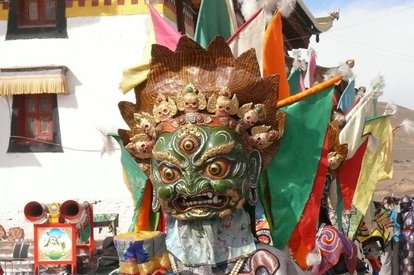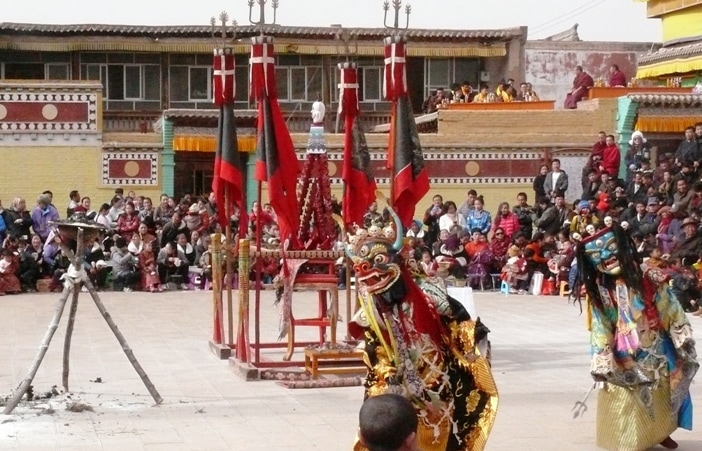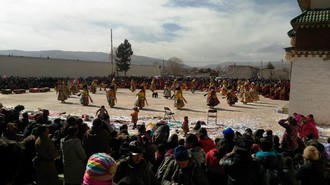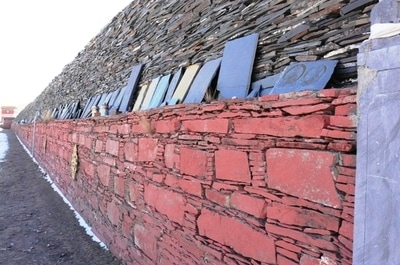TNY2017 - REPORT
(2 - 17 february 2017)
The eyes have it - a friend at Se Monastery (Jonang) in Aba.
It was a most fantastic excursion. Susan and I were joined by five inquisitive travelers (including three returnees), our three excellent drivers with their Prada Land Cruisers, and the inimitable guide Tsedor.
The initial five days were spent in Repkong, participating in the usual round of Losar activities such as Displaying the Thangka, Maitreya Transportation, and Cham dance - all as interpreted by various Gelug monasteries in the area.
The initial five days were spent in Repkong, participating in the usual round of Losar activities such as Displaying the Thangka, Maitreya Transportation, and Cham dance - all as interpreted by various Gelug monasteries in the area.

Early in the morning of the first day we headed off to Gomar Monastery to participate in the Butter Tea Ceremony. But first there was the introductory surprise - apples, oranges, candies, potato chips, snacks, etc. delivered to the ceremony participants by happy teenager boys! They were up on the edge of the roofs of surrounding buildings with sacks of goodies and, at the appropriate moment, threw the treats and emptied the sacks into the outstretched arms and apron-skirts of the assemble and anxious (and happy) throng!
|
The Butter Tea Ceremony is an annual event at Gomar Monastery which previously was a single day event, but is now something that happens three day in a row. No other monasteries in the Repkong area have a Butter Tea Ceremony and it thus seems that since the event is so popular it is performed three times to accommodate all the celebrants.
A quick look at the assembled multitude in the monastery courtyard will attest to its popularity ... women and children on one side and the men on the other side. |
|
After the candies have been thrown down to everyone, and after families have taken their places in the courtyard, everyone awaits the arrival of the milk butter tea. This delicious mixture has been prepared in the huge kitchen vats of the monastery kitchen located to the side of the Chanting Hall. The tea is then carried from the kitchen in wooden barrels strapped on the backs of local women. (Recently the supply of wooden barrels was insufficient to meet the needs of all the people, so some tea is carried in metal buckets, one on each end of a shoulder pole.) The tea is then ladled out into cups or mugs and lustily consumed by a grateful congregation.
|
|
During our time in Repkong, we once again visited Sengeshong Magotsang (Xia Wutun) to witness the annual Displaying the Thangka (also - incorrectly - called Sunning the Buddha). A small group made their way up the path the thangka would take to the top of the hill, passing along the way a grouping of laptse flags in honor of the local mountain god. Once at the top we waited for the thangka and entourage to arrive and for the thangka to be rolled down the face of the display hill. When the cover was removed the Living Buddha gazed on it along with the assembled believers.
|

The following day we headed west to visit the largest Bon sect monastery in the Repkong area.
Bongya Monastery is a stunning place, sitting atop two south facing slopes with a (cleansing) stream flowing across its front. We watched the Maitreya Transportation ceremony and joined in the kora around the monastery, following the statue and pilgrim monks counter-clockwise around the perimeter of this pleasant place.

Returning from Bongya, we stopped in ZhangJia village to witness the local Shaman Festival. We had seen this ceremony for the previous two years, and this year the interaction with the Shaman was shorter than previous years. It was reported by locals that the mountain god was unhappy with the morality of the villagers during the past year and hoped they could improve their lifestyle and have a happier community. This could also result in a longer and more interactive visit by the mountain god next year. This photo shows the Shaman as he prepares for his invocations on behalf of the mountain god.
|
Having completed our visits in Repkong, we mounted our Land Cruisers and headed south to Ngawa (Aba). We drove through spectacular grasslands and stunning scenery as we crossed mountain tops in excess of 4000 meters (13,000 feet). Yaks and sheep/goats abound and there is some meaningful, and mirthful, signage just to keep you awake and smiling. |

Our first visit in Aba was to Gomang Monastery located to the west of town. Gomang is a large and extensive monastery housing approximately 600 monks. It is an architecturally significant Gelug monastery which is off the beaten track for most tour buses and multi-camera long lens photographers. We watched the Displaying the Thangka ceremony and were happy to speak with the Disciplinarian. In this photo are (L to R) Tsedor our guide, myself, Disciplinarian, and his Office Holding Bar monk. In the background is the thangka on the displaying hill.
|
Throughout our trip we continually saw young girls who were dressed up for the event and anxious to display their costumes to everyone. Here is one representative four year old at Gomang Monastery. |
Two days later we attended the Gomang monastery Cham dance celebration. It starts with over 150 horses and riders in military garb parading into the monastery and up to the dance ground. These decorated horses and well-armed riders underscore the importance of the military in maintaining the theocratic Gelug government in the 18th and 19th centuries.
The cham dance itself is unlike those encountered in Amdo. At Gomang, twenty-two dancers, both Shanags and deities, form a circle as shown in the photo. While the circle itself does not rotate, the dancers perform in place although only for a short period of time. |
|
While the dance starts with the introductory parade of horses and armed riders to signify the importance of the military in history, other warriors are featured during the dance itself. These include archers, marksmen, and the penultimate military personage of the Kham and Amdo region of Old Tibet - King Gesar. His history is long, his lineage well known, and his importance unquestioned. And he looks pretty good too .... |
|
Setenling Gompa (Se Monastery) is a Jonang sect monastery located on the eastern edge of Aba town. It is a very peaceful place with a good feeling of friendship and support exuding from all we encountered. We had visited to see the Maitreya Transportation but this ceremony was postponed to another day and instead we witnessed the Displaying the Thangka. This photo shows the covered thangka hanging from the upper level of the administrative building. |

Lunchtime at Se monastery - rice and dates in some soy milk - delivered by barefoot novitiates to their seniors who are chanting in the Assembly Hall.
|
In the center of Aba town is Kirti Monastery, another Gelug sect gompa. They have a Cham dance somewhat similar to that of Gomang monastery in that they also have a parade of horses and armed riders before the start of the dance. This year the Cham was performed in the courtyard area in front of the Chanting and Assembly Halls underneath a full transparent plastic covering installed a few months ago.
Another activity particular to Kirti Monastery is held in an open area south of the kitchen, at the edge of which is a gnarly tree stump. This features as the centerpiece of the Kirti Wood Break dance. |
|
In the evening, which corresponds to the Lantern Festival held in China on the fifteenth day of the New Year, Kirti Monastery unveils its large and elaborate butter sculpture. Only a few of the larger monasteries have a Butter Sculpture Display such as Kumbum and Labrang, The 6 x 4 meter sculpture was placed in the covered area in front of the Chanting Hall. Participants came close to have a better look at the detail of the characters and adornments and to place or thrown khatas at the sculpture. As you can see in the photo, some of the khatas stuck to the sculpture - an additional piece of merit and good luck! |
Nearing the end of our excursion into Aba and area, we headed northeast a few kilometers to visit Nangzhik Monastery (called Narshi by the locals), which is the largest Bon monastery in this area. We went on the day of the Bon Cham dance. Narshi is a traditional (non-reformed) Bon monastery.
The cham is influenced by local history and custom and starts with a parade of horses and riders into the courtyard where the riders ring the edge of the dance area. The cham itself is quite different from Gelug cham dance formats and will be the subject of a separate section in this website.

The main dancer, and the leader of the priority procession of cham dancers is a green faced deity ...
... with seven (7) skulls on his head ...
... not the normal and maximum five (5) skulls experienced in cham dances of other sects.
Initial identification has been difficult, but there is a consensus that this deity represents Sipai Gyalmo a prominent Bon wrathful deity.
|
Before leaving Aba and the Narshi Bon area, we visited Topgyal Monastery across the valley. This monastery is extensive and overlooks Narshi. This is shown in the photo which shows the roof of the main Chanting Hall, one of five larger buildings that form the monastery. In the background is Narshi. Additionally, to the east of Topgyal are the ruins of a structure dating from over one thousand years ago which met its demise during the events of 1966 - 1976, Topgyal is a Reformed Bon monastery which recognizes Padmasambhava and others in the larger Tibetan Buddhism realm. |
|
Finally it was time to leave Aba and Kham and head back up north. We traveled from Sichuan province through a small part of Gansu province and then back into Qinghai province - we went from Kham back into Amdo! We saw more spectacular scenery, dizzying heights, grasslands stretching as far as the eye could see, sheep and goats, and of course lots of yaks. We even saw one yak that was working for its barley!! |
We made a short diversion from our direct route to Repkong and Xining and jogged to the west to visit the town of Hor and its famous Mani Wall.
This is a 600 meter long wall of carved slate stones holding the complete texts of both the Kanjur and the Tanjur. The photos below show the wall looking from east to west and a section of the carved slates. One can notice the carved inscriptions on each stone and also the fact that the slates are piled face down to avoid water pooling and subsequent damage during the rainy season.
The wall is located atop a hill overlooking Terton Chogar Gompa, a Nyingma monastery.
On our final day, before leaving Xining to return to Beijing, we visited The Qinghai Tibetan Medical and Cultural Museum. This museum houses the world's longest thangka measuring 420 meters in length.
The thangka tells the story of Tibetan history and culture. It was painted by a number of famous Tibetan thangka painters and its level of detail is inspirational. Below I have shown two photos, one illustrating the origin of the Tibetan people with the union of a monkey and an ogress, the other showing portions of the Mitra Mandala.
And so it was that our excursion came to an end after more than two weeks of adventure, excitement, and challenge.
The TNY2017 adventure was an eye-opener with respect to the Bon sect, its thangkas and murals, and its celebrations. Of particular note are the differences and other attributes of its Cham dance ...
... more on this in a separate link!
O ma ni pad me hum




















